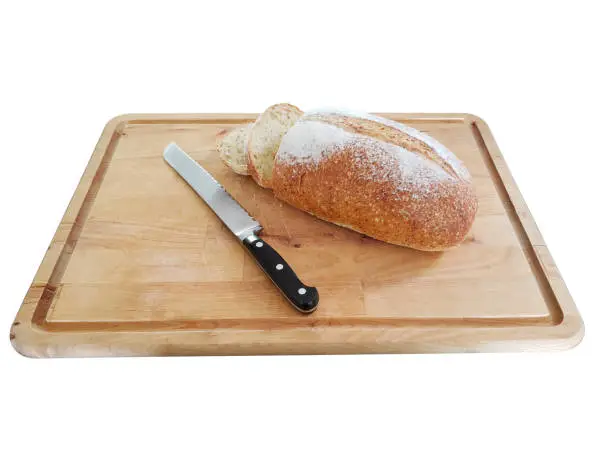Bread knives are a common tool in most kitchens, and they have a very distinct feature: serrated blades. The serration on the blade allows the knife to cut through bread with ease, without crushing or squashing the loaf. Unlike regular knives, which have straight edges, serrated knife store feature a jagged edge that mimics the teeth of a saw. This design helps the blade grip and cut through crusty bread, making it an essential tool for bakers and home cooks alike. The serrated blade is more effective at slicing through crusty bread, which is often tough on the outside but soft and airy inside.
Serrated Blades Reduce Crumbs and Mess
One of the main advantages of a serrated bread knife is its ability to reduce crumbs when cutting through bread. Bread can often create a mess if it’s sliced with a dull or straight-edged bread knife. The serrated teeth on a bread knife help to minimize this problem by effectively cutting through the loaf with minimal pressure. As a result, fewer crumbs are created, and the loaf remains intact. This feature is especially important for those who want clean slices, particularly when serving bread to guests or using it for sandwiches. Less mess means a cleaner kitchen and easier cleanup after baking.
Perfect for Cutting Crusty Bread
Crusty bread, such as baguettes or artisan loaves, often has a tough outer crust that can be difficult to cut through. A serrated bread knife is perfect for this job because its jagged edges can slice through the hard crust while leaving the soft interior of the bread intact. The teeth of the serrated blade grip the crust, enabling the knife to cut more efficiently. A smooth-edged knife would have difficulty getting through the tough crust without compressing the inner, airy part of the bread. Therefore, the serration is essential for getting that perfect slice without damaging the loaf.
Even Slices with Serrated Blades
Bread knives with serrated edges are designed to make evenly sized slices, even when the bread is unevenly shaped. The jagged teeth of the blade cut into the loaf in a way that ensures each slice is uniform in thickness, regardless of the bread’s shape or size. This is important, especially for presentations or when making sandwiches, where evenly sliced bread is necessary. Straight-edged knives can sometimes lead to uneven slices, which can make the bread look messy or unappealing. Serrated blades, however, glide through the loaf with little effort, leaving behind evenly cut portions every time.
Minimal Pressure for Clean Cuts
The serrated edge of a bread knife works with minimal pressure, which is one of the reasons why it’s so effective at cutting through bread without smashing it. When using a straight-edged knife, more force is required to cut through bread, often resulting in the loaf being compressed or squashed. In contrast, the serrated teeth help to slice through the loaf with a back-and-forth motion that requires little force. This motion is gentle on the bread, allowing the knife to cut through without disturbing the texture of the interior. This characteristic makes the serrated bread knife more effective than standard knives for slicing delicate bread.
Long-Lasting Performance of Serrated Blades
Serrated blades are also known for their longevity. Over time, a straight-edged knife will dull and require sharpening. However, a serrated bread knife maintains its sharpness for a longer period due to the design of the blade. The teeth are less likely to become dull as quickly as a straight-edged blade, meaning the bread knife stays effective for longer. This is an advantage for home bakers and professional chefs alike, as it reduces the need for frequent sharpening. Even with regular use, the serrated edge of a bread knife remains sharp enough to cut through bread with ease.
Suitable for Different Types of Bread
Another key advantage of serrated bread knives is their versatility. These knives are not only ideal for cutting crusty breads but can also be used for softer varieties. Whether you are cutting a loaf of sandwich bread or a more delicate type of baked good, a serrated bread knife can handle the task. Its ability to adapt to different bread types makes it a go-to tool in any kitchen. From soft white bread to tough sourdough, the serrated blade allows for consistent and easy slicing. This makes it an essential tool for anyone who enjoys baking or eating a variety of bread types.
Safety Features of Serrated Blades
The design of serrated bread knives also adds an element of safety when compared to straight-edged knives. The serrated teeth make it harder for the blade to slip during slicing, reducing the likelihood of accidents. The teeth grip the bread, providing better control over the knife’s movement and making it less likely to slip off the loaf and cause injury. Additionally, serrated blades are often longer than standard knives, offering more stability when cutting through larger loaves of bread. This added stability makes serrated knives a safer option for both professional and home bakers.
Must-Have for Every Kitchen
In conclusion, the serrated blade is a must-have for every kitchen, particularly for those who regularly bake or enjoy fresh bread. Its unique design allows for cleaner, easier cuts through a variety of bread types, reducing mess and preserving the loaf’s structure. Whether you are slicing crusty baguettes, soft sandwich bread, or anything in between, a serrated bread knife makes the task easier. Its longevity, safety, and efficiency make it a valuable kitchen tool that ensures you get the perfect slice every time. With all of these benefits, it’s clear that the serrated bread knife deserves a place in every home kitchen.
